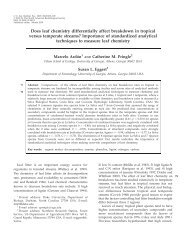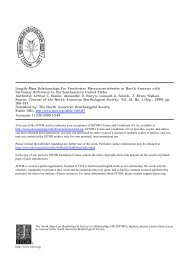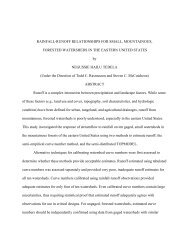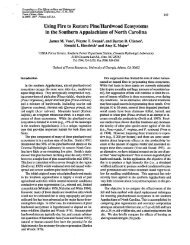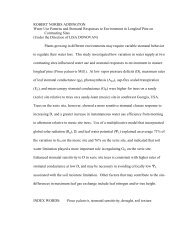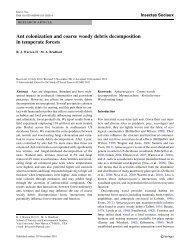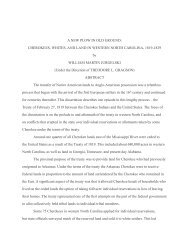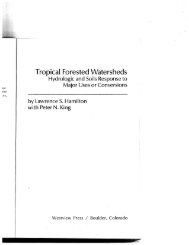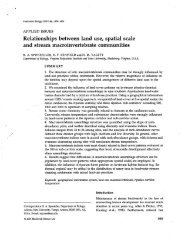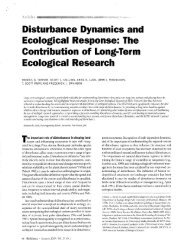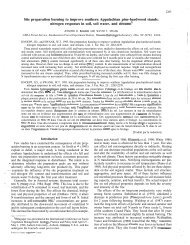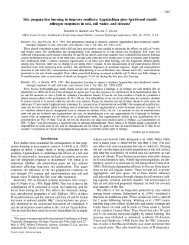biology join - Coweeta LTER - University of Georgia
biology join - Coweeta LTER - University of Georgia
biology join - Coweeta LTER - University of Georgia
Create successful ePaper yourself
Turn your PDF publications into a flip-book with our unique Google optimized e-Paper software.
Articles<br />
(Mazhitova et al. 2008), whereas other sites have shown little<br />
change (Zamolodchikov et al. 2008). However, recent data<br />
have shown that active-layer depth measurements alone may<br />
obscure the degradation <strong>of</strong> permafrost, because the ground<br />
Table 1. Components <strong>of</strong> the global cryosphere and their areal extent.<br />
Component Definition and remarks<br />
Snow Perennial or seasonal cover <strong>of</strong><br />
the land surface: 98% in Northern<br />
hemisphere<br />
Glaciers Perennial snow or ice that moves<br />
Alpine glaciers and ice caps<br />
surface subsides as permafrost thaws and internal ice melts.<br />
This subsidence process (called thermokarst) can radically<br />
restructure surface hydrology by altering the dynamics<br />
<strong>of</strong> water bodies, initiating or expanding surface channel<br />
incision, and drying surface soil<br />
Extent<br />
(in 10 6 km 2 ) <strong>LTER</strong> site(s) a<br />
1.9 (summer)<br />
45 (winter)<br />
ARC, AND, BNZ, CDR,<br />
KBS, KNZ, HBR, HFR,<br />
MCM, NTL, NWT,<br />
SGS, PIE,<br />
0.53 MCM, NWT, PAL<br />
Ice sheets 14 MCM, PAL<br />
Permafrost Subsurface Earth material remaining<br />
below 0 degrees Celsius for at least<br />
2 years<br />
23 ARC, BNZ, MCM,<br />
NWT<br />
Lake and river ice Seasonal cover <strong>of</strong> lakes and rivers ? ARC, AND, BNZ, CDR,<br />
KBS, KNZ, HBR, HFR,<br />
MCM, NTL, NWT,<br />
SGS, PIE<br />
Sea ice Perennial or seasonal cover <strong>of</strong> the<br />
ocean<br />
19–27 PAL<br />
Note: All extents are from table 4.1 <strong>of</strong> Solomon and colleagues (2007). The value for permafrost is the<br />
region in which permafrost occurs and includes both frozen and unfrozen soils.<br />
km 2 , square kilometers; <strong>LTER</strong>, long-term ecological research.<br />
a See table 2 for the site abbreviations.<br />
a b<br />
layers. Observations near Toolik<br />
Lake, Alaska, have shown rapid<br />
mass wasting <strong>of</strong> surface soils<br />
undergoing thaw, which resulted<br />
in an increased loading <strong>of</strong> suspended<br />
sediment in streams,<br />
with direct and indirect effects<br />
on stream biota (Bowden et al.<br />
2008). In the McMurdo Dry<br />
Valleys <strong>of</strong> Antarctica, enhanced<br />
incision <strong>of</strong> stream water into<br />
massive subsurface ice has caused<br />
one river to flow underground<br />
for some distance. At Niwot Ridge<br />
in Colorado, increasing water<br />
flow and solute concentrations in<br />
early autumn have been attributed<br />
to the melting <strong>of</strong> alpine<br />
permafrost (Caine 2010).<br />
One iconic and highly conspicuous<br />
feature <strong>of</strong> global warming<br />
is glacier recession (figure 2b).<br />
Figure 1. Approximate geographic limits <strong>of</strong> the cryosphere. (a) January climatology <strong>of</strong> Northern Hemisphere sea ice<br />
(measured between 1979 and 2005) and snow extent (measured between 1967 and 2005) with the North Pole referenced<br />
(the red dot). (b) September climatology <strong>of</strong> Southern Hemisphere sea ice (measured between 1979 and 2003) and snow<br />
extent (measured between 1987 and 2002) with the South Pole referenced (the red dot). Source: Reprinted from John<br />
Maurer, Atlas <strong>of</strong> the Cryosphere. National Snow and Ice Data Center (2007; http://nsidc.org/data/atlas).<br />
406 BioScience • April 2012 / Vol. 62 No. 4 www.biosciencemag.org



